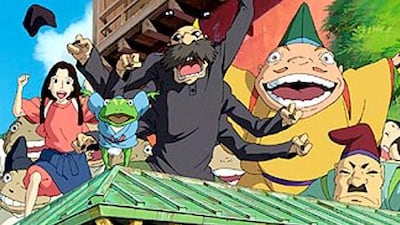From Dorothy in The Wizard of Oz to Alice and her adventures in Wonderland, it seems like being whisked away to magical realms governed by madcap rulers is simply one of the hazards of being young and female. That's the situation in which Chihiro finds herself - complete with dragons, glowing steamships and levitating frogs - in Spirited Away.
The Japanese hand-drawn animation, which celebrates its 10th birthday this week, has yet to reach adolescence itself, but during its short lifetime the coming-of-age story has become recognised as a masterpiece of world cinema.
A former Berlin Film Festival winner, Spirited Away helped anime ditch its reputation outside Japan as a genre for fans of hardware, explosions and voyeurism. But the movie is no art house concern either; as well as displacing Titanic as the highest-grossing film in Japanese box office history, it became the first anime to win an Academy Award. One of its greatest champions, the Toy Story director John Lasseter, personally oversaw the film's English-language dubbing and release.
Written and directed by master animator Hayao Miyazaki, now 70, the film overflows with the sense of fantasy and wonder that young viewers adore, but also the ideas-driven storytelling that mature audiences demand. Then there are the visuals: lush watercolour-inspired vistas, replete with intricately designed and often grotesque characters - the calling card of the Miyazaki-founded Studio Ghibli animation house, whose movies are considered the gold standard of anime.
The fairytale begins as many others do, with a sheltered and slightly selfish girl who is upset when her family decides to leave the familiarity of her childhood home. But after passing through a mysterious tunnel in a secluded forest, Chihiro finds herself in a far more worrisome time and place than she could ever have imagined.
Upon setting foot in the new land - a surreal take on Edo period Japan, filled with the malevolent spirits of the country's ancient folklore - her parents are turned into animals. She is then forced to take cover in a giant cloud-ringed bathhouse and tend to supernatural beings of all shapes and sizes that visit. In a story that's every bit as bizarre as it sounds, the building's proprietor, Yubaba (an evil sorceress) conspires to enslave Chihiro by making the girl forget her own name.
"I felt [Japanese media] only offered such things as crushes and romance to 10-year-old girls," Miyazaki told Animage magazine at the time of the film's release. "Looking at my young friends, I felt this was not what they held dear in their hearts, not what they wanted. And so I wondered if I could make a movie in which they could be heroines."
Although Spirited Away went further than any of the director's other films in its attempt to bridge the gap between young and mature audiences, his use of strong female protagonists was not new. In his other movies, such as Nausicaä of the Valley of the Wind, My Neighbour Totoro and Kiki's Delivery Service, young women are depicted as considerably more honest and heroic than their bumbling male counterparts. But despite the overt and much-discussed feminism inherent in his work, it would be a mistake to characterise Miyazaki simply as a "progressive".
"There's a lot of nostalgia for the past, traditional values and also the idea of empowerment through labour," says the author Andrew Osmond, who included the movie in his book 100 Animated Feature Films. He believes the story, with its ancient setting and folkloric creatures, acts as a critical commentary on modern Japan and the challenges caused by the country's economic difficulties.
"There's a pivotal scene with a river spirit - a giant worm-like thing - which the heroine has to clean. When she does, you get this huge mountain of rubbish that comes out, including old bicycles, so there's the idea that the river has been made filthy by everything that's accumulated in modern Japan."
The idea came to Miyazaki after participating in a river-cleaning himself, finding among other things, a bicycle. The filmmaker's urge to subtly examine social and environmental issues through fantasy reveals a depth that is all too often missing from American animation.
While a question mark currently hangs over Miyazaki's directing future (he threatened to retire after 2008's Ponyo, although not for the first time), Spirited Away's international standing has helped introduce countless film fans around the world to the wonders of anime.
What's more, recent Pixar movies such as Wall-E, Up and Toy Story 3 have shown greater complexity and emotional nuance than any of the studio's previous efforts, suggesting that Miyazaki's artistic legacy will continue to be felt beyond the shores of Japan. In fact, Pixar director Lasseter makes no secret of it, once writing: "When we have a problem and we can't seem to solve it, we often look at one of his films in our screening room. Toy Story owes a huge debt of gratitude to the films of Mr Miyazaki."

